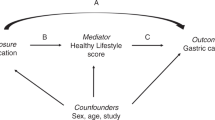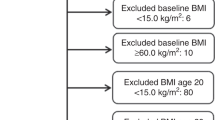Abstract
Background/objectives:
Cross-sectionally, educational attainment is strongly associated with the prevalence of obesity, but this association is less clear for weight change during adult life. The objective of this study is to examine the association between educational attainment and weight change during adult life in the European Prospective Investigation into Cancer and Nutrition (EPIC).
Subjects/methods:
EPIC is a cohort study with 361 467 participants and up to 10 years of follow-up. Educational attainment was categorized according to the highest obtained school level (primary school or less, vocational secondary training, other secondary education and university). Multivariate mixed-effects linear regression models were used to study education in relation to weight at age 20 years (self-reported), to annual change in weight between age 20 years and measured weight at recruitment, and to annual change in weight during follow-up time.
Results:
Higher educational attainment was associated with on average a lower body mass index (BMI) at age 20 years and a lower increase in weight up to recruitment (highest vs lowest educational attainment in men: −60 g per year (95% confidence interval (CI) −80; −40), women −110 g per year (95% CI −130; −80)). Although during follow-up after recruitment an increase in body weight was observed in all educational levels, gain was lowest in men and women with a university degree (high vs low education −120 g per year (95% CI −150; −90) and −70 g per year (95% CI −90; −60), respectively).
Conclusions:
Existing differences in BMI between higher and lower educated individuals at early adulthood became more pronounced during lifetime, which possibly impacts on obesity-related chronic disease risk in persons with lower educational attainment.
This is a preview of subscription content, access via your institution
Access options
Subscribe to this journal
Receive 12 print issues and online access
$259.00 per year
only $21.58 per issue
Buy this article
- Purchase on Springer Link
- Instant access to full article PDF
Prices may be subject to local taxes which are calculated during checkout


Similar content being viewed by others
References
Finucane MM, Stevens GA, Cowan MJ, Danaei G, Lin JK, Paciorek CJ et al. National, regional, and global trends in body-mass index since 1980: systematic analysis of health examination surveys and epidemiological studies with 960 country-years and 9·1 million participants. Lancet 2011; 377: 557–567.
Wyatt SB, Winters KP, Dubbert PM . Overweight and obesity: prevalence, consequences, and causes of a growing public health problem. Am J Med Sci 2006; 331: 166–174.
Zhang Q, Wang Y . Trends in the association between obesity and socioeconomic status in U.S. adults: 1971 to 2000. Obesity Res 2004; 12: 1622–1632.
Molarius A, Seidell JC, Sans S, Tuomilehto J, Kuulasmaa K . Educational level, relative body weight, and changes in their association over 10 years: an international perspective from the WHO MONICA Project. Am J Public Health 2000; 90: 1260–1268.
Ball K, Crawford D . Socioeconomic status and weight change in adults: a review. Soc Sci Med 2005; 60: 1987–2010.
Riboli E, Hunt KJ, Slimani N, Ferrari P, Norat T, Fahey M et al. European Prospective Investigation into Cancer and Nutrition (EPIC): study populations and data collection. Public Health Nutr 2002; 5: 1113–1124.
Haftenberger M, Lahmann PH, Panico S, Gonzalez CA, Seidell JC, Boeing H et al. Overweight, obesity and fat distribution in 50- to 64-year-old participants in the European Prospective Investigation into Cancer and Nutrition (EPIC). Public Health Nutr 2002; 5: 1147–1162.
Spencer EA, Appleby PN, Davey GK, Key TJ . Validity of self-reported height and weight in 4808 EPIC-Oxford participants. Public Health Nutr 2002; 5: 561–565.
Spencer EA, Roddam AW, Key TJ . Accuracy of self-reported waist and hip measurements in 4492 EPIC-Oxford participants. Public Health Nutr 2004; 7: 723–727.
Wareham NJ, Jakes RW, Rennie KL, Schuit J, Mitchell J, Hennings S et al. Validity and repeatability of a simple index derived from the short physical activity questionnaire used in the European Prospective Investigation into Cancer and Nutrition (EPIC) study. Public Health Nutr 2003; 6: 407–413.
Hermann S, Rohrmann S, Linseisen J, May AM, Kunst A, Besson H et al. The association of education with body mass index and waist circumference in the EPIC-PANACEA study. BMC Public Health 2011; 11: 169.
Must A, Willett WC, Dietz WH . Remote recall of childhood height, weight, and body build by elderly subjects. Am J Epidemiol 1993; 138: 56–64.
Klipstein-Grobusch K, Kroke A, Boeing H . Reproducibility of self-reported past body weight. Eur J Clin Nutr 1998; 52: 525–528.
Park JY, Mitrou PN, Keogh RH, Luben RN, Wareham NJ, Khaw KT . Effects of body size and sociodemographic characteristics on differences between self-reported and measured anthropometric data in middle-aged men and women: the EPIC-Norfolk study. Eur J Clin Nutr 2011; 65: 357–367.
Rissanen AM, Heliovaara M, Knekt P, Reunanen A, Aromaa A . Determinants of weight gain and overweight in adult Finns. Eur J Clin Nutr 1991; 45: 419–430.
Sundquist J, Johansson SE . The influence of socioeconomic status, ethnicity and lifestyle on body mass index in a longitudinal study. Int J Epidemiol 1998; 27: 57–63.
van Lenthe FJ, Droomers M, Schrijvers CT, Mackenbach JP . Socio-demographic variables and 6 year change in body mass index: longitudinal results from the GLOBE study. Int J Obes Relat Metab Disord 2000; 24: 1077–1084.
Regidor E . Measures of health inequalities: part 2. J Epidemiol Comm Health 2004; 58: 900–903.
Braam LA, Ocke MC, Bueno-de-Mesquita HB, Seidell JC . Determinants of obesity-related underreporting of energy intake. Am J Epidemiol 1998; 147: 1081–1086.
Johansson G, Wikman A, Ahren AM, Hallmans G, Johansson I . Underreporting of energy intake in repeated 24 h recalls related to gender, age, weight status, day of interview, educational level, reported food intake, smoking habits and area of living. Public Health Nutr 2001; 4: 919–927.
Goris AH, Westerterp-Plantenga MS, Westerterp KR . Undereating and underrecording of habitual food intake in obese men: selective underreporting of fat intake. Am J Clin Nutr 2000; 71: 130–134.
Liberatos P, Link BG, Kelsey JL . The measurement of social class in epidemiology. Epidemiol Rev 1988; 10: 87–121.
Acknowledgements
The work described in this paper was carried out with support of the European Commission: Grant No. DG Sanco, Project No.: 2 005 328. The work was further financially supported by the European Commission: Public Health and Consumer Protection Directorate 1993–2004; Research Directorate General 2005'; Ligue contre le Cancer, Societé 3M, Mutuelle Générale de l'Education Nationale, Institut National de la Santé et de la Recherche Médicale (INSERM) (France); German Cancer Aid, German Cancer Research Centre, Federal Ministry of Education and Research (Germany); Danish Cancer Society (Denmark); Health Research Fund (FIS) of the Spanish Ministry of Health, the participating regional governments and institutions (Spain); Cancer Research UK, Medical Research Council, Stroke Association, British Heart Foundation, Department of Health, Food Standards Agency, Wellcome Trust (UK); Greek Ministry of Health and Social Solidarity, Hellenic Health Foundation and Stavros Niarchos Foundation (Greece); Italian Association for Research on Cancer, National Research Council (Italy); Dutch Ministry of Public Health, Welfare and Sports, Dutch Ministry of Health, Dutch Prevention Funds, LK Research Funds, Dutch ZON (Zorg Onderzoek Nederland), World Cancer Research Fund (WCRF; The Netherlands); Swedish Research Council, Swedish Heart-Lung Foundation, Swedish Cancer Foundation, Swedish Cancer Society, Swedish Scientific Council, Regional Government of Skane (Sweden); Norwegian Cancer Society (Norway).
Author contributions
PHMP: principal investigator of the EPIC-PANACEA project and guarantor of the article; the EPIC study was conceptualized, designed and implemented in collaboration with the main investigators in the collaborating countries as follows: Denmark (A Tjønneland, KO), France (FC-C and M-CB-R), Germany (RK), Greece (A Trichopoulou), Italy (RT), Netherlands (HBB-d-M and PHMP), Norway (EL), Spain (M-DC, LR and M-JS), Sweden (IJ) and United Kingdom (NW and K-TK; these authors contributed to the study design, subject recruitment, and data collection and acquisition, and are responsible for the ongoing follow-up and management of the EPIC cohort); SR, J Linseisen and SH: conceived the current study; SR, A Steinbrecher and J Linseisen: responsible for the design of the study, analyses of data, interpretation of results and drafting of the manuscript, with close assistance from SH, AMM, J Luan and PHMP, and taking into account the comments and suggestions of the coauthors; contributors from the collaborating centers (UE, JH, GF, CA, GM, AM, FR, NT, PA, EA, LR, LMN, BH, MR, TB, AN, PO, SvdB, MMB, A Steffen, BT, FLC, A-KI, SN, VG, TM, TN): provided the original data, information on the respective populations, and advice on study design, analysis and interpretation of the results; and all coauthors had the opportunity to comment on the analysis and interpretation of the findings, and approved the final version of the manuscript.
Author information
Authors and Affiliations
Corresponding author
Ethics declarations
Competing interests
The authors declare no conflict of interest.
Rights and permissions
About this article
Cite this article
Rohrmann, S., Steinbrecher, A., Linseisen, J. et al. The association of education with long-term weight change in the EPIC-PANACEA cohort. Eur J Clin Nutr 66, 957–963 (2012). https://doi.org/10.1038/ejcn.2012.55
Received:
Revised:
Accepted:
Published:
Issue Date:
DOI: https://doi.org/10.1038/ejcn.2012.55
Keywords
This article is cited by
-
Association of health behaviors, dietary habits, and oral health with weight gain after 20 years of age in community-dwelling Japanese individuals aged 40 years and older: a cross-sectional study
Clinical Oral Investigations (2023)
-
Impact of community lifestyle intervention on anthropometric parameters and body composition among overweight and obese women: findings from the MyBFF@home study
BMC Women's Health (2018)
-
A systematic review of the effectiveness of individual, community and societal-level interventions at reducing socio-economic inequalities in obesity among adults
International Journal of Obesity (2014)
-
Body mass index and cancer incidence: the FINRISK study
European Journal of Epidemiology (2014)



